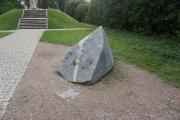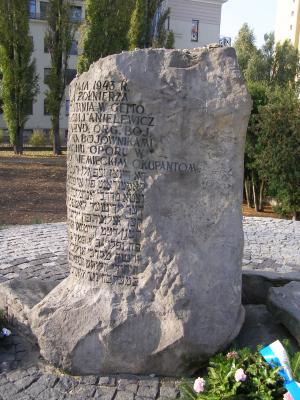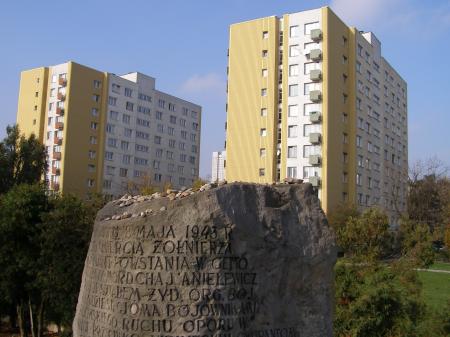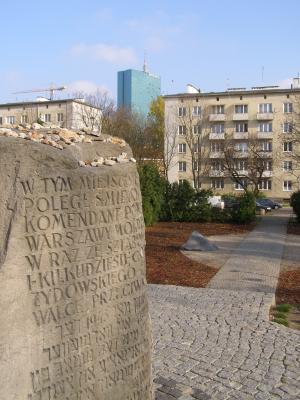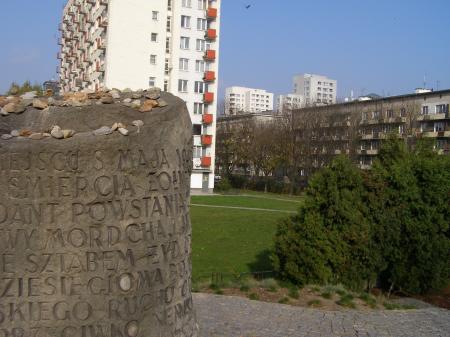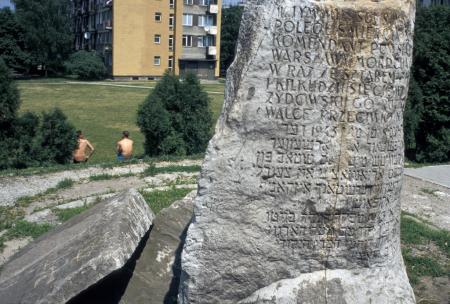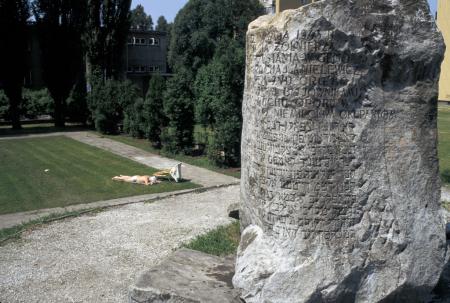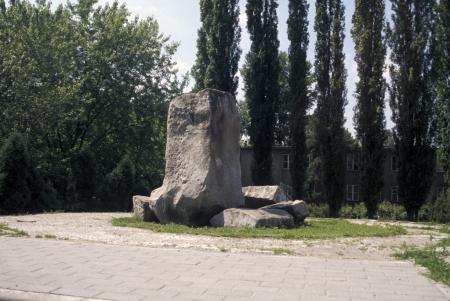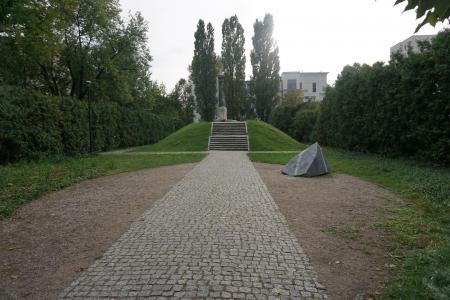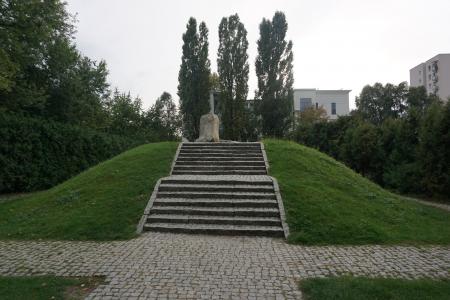Obj. ID: 49737
Modern Jewish Art Mila 18 Bunker Site and Memorial in Warsaw, Poland, 1946

Memorial Name
Mila 18 Bunker Site and Memorial
Who is Commemorated?
Mordechai Anielowicz and the Ghetto fighters entombed in the bunker
Description
The memorial site is a mound of rubble, now covered with dirt and greenery. This mound is believed to cover the remains of the bunker in which many ZOB fighters are entombed. Two levels of broad low cobblestone steps lead to the top of the mound. The lower level has seven steps; the upper level has eight.
At the top of the mound is a circular space paved with cobblestones. On top of this is a vertically set, roughly carved, vaguely cylindrical boulder, with a tri-lingual inscription across its rounded front. The memorial stone is set amid large rough stones, piled at its base. These lie horizontally like fallen gravestones. A half-ring of tall slender cypress trees borders the rear of the paved area – opposite the steps.
A triangular stone was placed in the 2000s on the northern side of the path leading to the mound:
A block dedicated to Mordechai Anielewicz - one of the blocks in Memorial Route of Martyrdom and Struggle of Jews, is situated at the entrance to the site (see here).
Inscriptions
Polish:
W TYM MIEJSCU 8 MAJA 1943 R.
POLEGŁ SMIERCIĄ ŻOŁNIERZA
KOMENDANT POWSTANIA W GETTO
WARSZAWY MORDECHAJ ANIELEWICZ
W RAZ ZE SZTABEM ZVD. ORG. BOJ
I- KILKUDZIESIĘ CIOMA W BOJOWNIKAMI
ŻYDOWSKIEGO RUCHU OPORU W
WALCE PRZECIWKO NIEMIECKIM OKUPANTOM.
Translation: On May 8, 1943, in this place, Mordechai Anielewicz - the commander of the Warsaw Ghetto Uprising, died as a soldier, together with the headquarters of the Jewish Combat Organization and several dozen fighters of the Jewish resistance fighting against the German occupiers.
Yiddish
דא זיינען געפאלן דעם 8-טן מאי 1943 דער
קאמענדאנט פון אויפשטאנד אין ווארשעווער
געטא מרדכי אניעלעוויטש מיט דעם שטאב פון
דער יידישער קאמפס ארגאניזאציע און צענדלי-
קער זעלנער פון יידישן ווידערששטאנד אין קאמף
קעגן דעמ [דעם] דייטשנ אקופאנט.
Translation: On May 8, 1943, in this place, Mordechai Anielewicz - the commander of the Warsaw Ghetto Uprising, fell together with the headquarters of the Jewish Combat Organization and several dozen fighters of the Jewish resistance fighting against the German occupier.
Hebrew
פה נפלו ב-8 במאי 1943 מפקד המרד בגיטו
ורשה מרדכי אנילביץ' יחד עם מטה הארגון
היהודי הלוחם ועשרות לוחמי המרי היהודי
במערכה נגד האויב הנאצי.
Translation: Here, on May 8, 1943, Mordechai Anielewicz - the commander of the Warsaw Ghetto Uprising, fell together with the headquarters of the Jewish Combat Organization and several dozen fighters of the Jewish resistance fighting in a war against the Nazi enemy.
Commissioned by
Central Committee of Polish Jews
sub-set tree:
Mila 18 was the headquarters "bunker" of the Jewish Combat Organization (ŻOB), a Jewish resistance group in the Warsaw Ghetto. The bunker at Miła 18 was constructed by smugglers in 1943. The ŻOB fighters arrived there after their own hideout, at 29 Miła Street, had been discovered.
In July 1945 survivors of the Jewish Underground (Among them Simcha Rotem) visited the ruins above the Command bunker. The bodies of Jewish fighters were not exhumed after 1945 and the place gained the status of war memorial.
In 1946, at the initiative of the Central Committee of Polish Jews, on the top of a mound made of rubble from neighboring houses, at the place where the bunker was located, an obelisk was erected with inscriptions in Polish, Yiddish, and Hebrew.
Gebert, Kontanty, “The Dialectics of Memory in Poland: Holocaust Memorials in Warsaw,” in James E. Young, The Art of Memory: Holocaust Memorials in History (New York: Jewish Museum, 1994), 121-129., 121-129.
“Anielewicz’s Bunker (Miła Street),” Virtual Shtetl website, https://sztetl.org.pl/en/towns/w/18-warsaw/116-sites-of-martyrdom/52425-anielewiczs-bunker-mila-street (accessed May 28, 2023)


